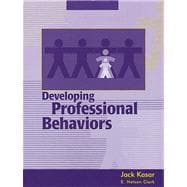
Note: Supplemental materials are not guaranteed with Rental or Used book purchases.
Purchase Benefits
Looking to rent a book? Rent Developing Professional Behaviors [ISBN: 9781556423161] for the semester, quarter, and short term or search our site for other textbooks by Kasar, Jack; Clark, E. Nelson. Renting a textbook can save you up to 90% from the cost of buying.
| Dedication | v | ||||
| Acknowledgments | xi | ||||
| About the Editors | xiii | ||||
| Contributing Authors | xv | ||||
| Introduction | xvii | ||||
| PART ONE: Behind the Scenes: Background and Underlying Factors | |||||
|
3 | (8) | |||
|
|||||
|
|||||
|
|||||
|
|||||
|
|||||
|
|||||
|
11 | (8) | |||
|
|||||
|
|||||
|
|||||
|
|||||
|
|||||
|
|||||
|
|||||
|
19 | (10) | |||
|
|||||
|
|||||
|
|||||
|
|||||
|
|||||
| PART TWO: The Right Stuff: Professional Behaviors | |||||
|
29 | (16) | |||
|
|||||
|
|||||
|
|||||
|
|||||
|
|||||
|
|||||
|
|||||
|
45 | (10) | |||
|
|||||
|
|||||
|
|||||
|
|||||
|
|||||
|
|||||
|
55 | (10) | |||
|
|||||
|
|||||
|
|||||
|
|||||
|
|||||
|
|||||
|
65 | (10) | |||
|
|||||
|
|||||
|
|||||
|
|||||
|
|||||
|
|||||
|
|||||
|
|||||
|
75 | (8) | |||
|
|||||
|
|||||
|
|||||
|
|||||
|
|||||
|
|||||
|
|||||
|
83 | (8) | |||
|
|||||
|
|||||
|
|||||
|
|||||
|
|||||
|
|||||
|
|||||
|
91 | (12) | |||
|
|||||
|
|||||
|
|||||
|
|||||
|
|||||
|
|||||
|
|||||
|
103 | (16) | |||
|
|||||
|
|||||
|
|||||
|
|||||
|
|||||
|
|||||
|
|||||
|
|||||
|
119 | (12) | |||
|
|||||
|
|||||
|
|||||
|
|||||
|
|||||
|
|||||
|
|||||
|
|||||
|
131 | (14) | |||
|
|||||
|
|||||
|
|||||
|
|||||
|
|||||
|
|||||
|
|||||
| PART THREE: Measuring Up: The Professional Development Assessment | |||||
|
145 | (12) | |||
|
|||||
|
|||||
|
|||||
|
|||||
|
|||||
|
|||||
|
|||||
| PART FOUR: Full Circle: Developing Professionalism in the Next Generation | |||||
|
157 | (8) | |||
|
|||||
|
|||||
|
|||||
|
|||||
|
|||||
|
|||||
|
|||||
|
165 | ||||
|
|||||
|
|||||
|
|||||
|
|||||
|
|||||
|
|||||
| PART FIVE: Reality Rehearsal: Structured Activities for Professional Behaviors | |||||
|
|||||
|
|||||
|
179 | (4) | |||
|
183 | (4) | |||
|
187 | (4) | |||
|
191 | (4) | |||
|
195 | (4) | |||
|
199 | (4) | |||
|
203 | (4) | |||
|
207 | ||||
| Appendix | 21 | (1) | |||
|
|||||
|
|||||
|
|||||
| Index | 21 |
The New copy of this book will include any supplemental materials advertised. Please check the title of the book to determine if it should include any access cards, study guides, lab manuals, CDs, etc.
The Used, Rental and eBook copies of this book are not guaranteed to include any supplemental materials. Typically, only the book itself is included. This is true even if the title states it includes any access cards, study guides, lab manuals, CDs, etc.